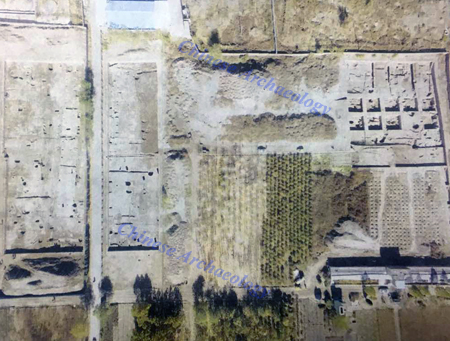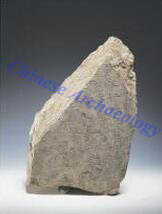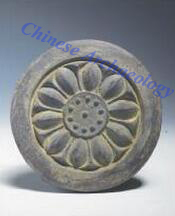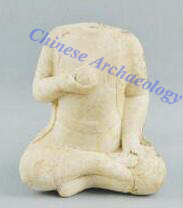Information
Large Temple Foundation Found in No.2 Building complex in Jinyang Ancient city, Shanxi province
Summary: From 2012 to 2016, Shanxi Provincial Institute of Archaeology and Taiyuan municipal Institute of cultural relics and Archaeology conducted an archeological investigation in the northwest area of the ancient city site, discovering a group of important buil
Large Temple Foundation Found in No.2 Building complex in Jinyang Ancient city, Shanxi province
From: Writer: Date:2017-03-24
Jinyang Ancient City Site was located in Jinyuan District, Taiyuan City, Shanxi Province, which covered an area of about 20 square kilometers. From 2012 to 2016, Shanxi Provincial Institute of Archaeology and Taiyuan municipal Institute of cultural relics and Archaeology conducted an archeological investigation in the northwest area of the ancient city site, discovering a group of important building complex remains, which was named as “No.2 building complex ruin in Jinyang Ancient City”.

The aerial photo showed the excavation area
This group of building complex was divided into two parts, the east and the west. The west part was built in Tang Dynasty and destroyed in the early Song Dynasty. The whole layout was intact. The whole building formed a closed multiple-courtyard quadrangle, facing south, laying out along with the axis, composed with walls, path, three courtyards, and a few three-courtyard quadrangles. From the water apron of the gate to north, every building’s horizontal plane rising a little gradually. The left and right’s horizontal plane was on the same level. Although the buildings along the axis weren’t excavated yet, it’s clear that the ones on the left and right were in the same period. Three rooms formed one group of the buildings on both sides, according to the size of the palace, the water aprons were different, which proved the length of the buildings’ eaves was different. The width of the building of both sides was similar, while the east one’s length was 1.5 m longer than the west. Among the buildings, the size of No.7 house foundation was larger, with larger scale of plinth and base, which was similar to a pavilion. House foundation No.1 and No.2 were the building between the courtyards on the axis.

The broken stele of Sixteen States Period
A broken Diamond Sutra stele was unearthed from the pit in front of the house foundation No. 7, while lots of broken steles were discovered between house foundations No. 6 and No. 8, therefore, according to the inscription on the steles, it could be concluded that the building should be a temple with Hall of Heaven Kings and Palace of Sakya, etc. Many remnant Buddhist stone pillars and exquisite stone carved building component, daily used ceramic, zoomorphic ornaments on the roofs, and a large number of bricks and tiles, etc. Through the analysis of the unearthed artifacts, this temple could be built during Tang Dynasty, and destroyed in the reign of Emperor Wuzong of Tang Dynasty, then repaired in Later Tang during the Five Dynasties, and finally devastated in early Song Dynasty.

Lotus pattern eaves tile of Northern Dynasty
The whole east building group could be divided into three periods. The earliest one belongs to Han Dynasty, which mainly was some house foundations and wells, with Four Symbols bricks and cloud pattern eaves tile as well as large stone building components unearthed. The second period architectural remains overlaid on the earliest one, the age of which was Wei-Jin and Sixteen States Period, with large cave cellars and house foundation discovered. The third period started building in East Wei Period, experienced North Qi, Sui Dynasties, and abandoned in Tang Dynasty. The building complex should be a courtyard around by houses, and the drainage channels were twisting and turning with special well and neat stone base.

Figure made of white marble
The excavation of two buildings revealed the different type of buildings in the same area during different times, which was significant for the study of ancient architecture’s layout and development, especially for the large temple architecture of Tang and Five Dynasties, the intact architectural structure plane of which was rare. Furthermore, the new discovered cultural layer and unearthed remains of Wei-Jin and Sixteen States Period should be the most clear scale plate for the archeological study of Wei-Jin and Sixteen States Period in Shanxi Province. According to the inscription of the remnant stone tablets, the excavated area could be the location of Jinyang Palace during North and Sui Dynasties, which need further archeological work to be proved. If that could be proved, it could be the important base for the further understanding of Jinyang ancient city’s layout in different times. (Translator: Lang Langtian)

The aerial photo showed the excavation area
This group of building complex was divided into two parts, the east and the west. The west part was built in Tang Dynasty and destroyed in the early Song Dynasty. The whole layout was intact. The whole building formed a closed multiple-courtyard quadrangle, facing south, laying out along with the axis, composed with walls, path, three courtyards, and a few three-courtyard quadrangles. From the water apron of the gate to north, every building’s horizontal plane rising a little gradually. The left and right’s horizontal plane was on the same level. Although the buildings along the axis weren’t excavated yet, it’s clear that the ones on the left and right were in the same period. Three rooms formed one group of the buildings on both sides, according to the size of the palace, the water aprons were different, which proved the length of the buildings’ eaves was different. The width of the building of both sides was similar, while the east one’s length was 1.5 m longer than the west. Among the buildings, the size of No.7 house foundation was larger, with larger scale of plinth and base, which was similar to a pavilion. House foundation No.1 and No.2 were the building between the courtyards on the axis.

The broken stele of Sixteen States Period
A broken Diamond Sutra stele was unearthed from the pit in front of the house foundation No. 7, while lots of broken steles were discovered between house foundations No. 6 and No. 8, therefore, according to the inscription on the steles, it could be concluded that the building should be a temple with Hall of Heaven Kings and Palace of Sakya, etc. Many remnant Buddhist stone pillars and exquisite stone carved building component, daily used ceramic, zoomorphic ornaments on the roofs, and a large number of bricks and tiles, etc. Through the analysis of the unearthed artifacts, this temple could be built during Tang Dynasty, and destroyed in the reign of Emperor Wuzong of Tang Dynasty, then repaired in Later Tang during the Five Dynasties, and finally devastated in early Song Dynasty.

Lotus pattern eaves tile of Northern Dynasty
The whole east building group could be divided into three periods. The earliest one belongs to Han Dynasty, which mainly was some house foundations and wells, with Four Symbols bricks and cloud pattern eaves tile as well as large stone building components unearthed. The second period architectural remains overlaid on the earliest one, the age of which was Wei-Jin and Sixteen States Period, with large cave cellars and house foundation discovered. The third period started building in East Wei Period, experienced North Qi, Sui Dynasties, and abandoned in Tang Dynasty. The building complex should be a courtyard around by houses, and the drainage channels were twisting and turning with special well and neat stone base.

Figure made of white marble
The excavation of two buildings revealed the different type of buildings in the same area during different times, which was significant for the study of ancient architecture’s layout and development, especially for the large temple architecture of Tang and Five Dynasties, the intact architectural structure plane of which was rare. Furthermore, the new discovered cultural layer and unearthed remains of Wei-Jin and Sixteen States Period should be the most clear scale plate for the archeological study of Wei-Jin and Sixteen States Period in Shanxi Province. According to the inscription of the remnant stone tablets, the excavated area could be the location of Jinyang Palace during North and Sui Dynasties, which need further archeological work to be proved. If that could be proved, it could be the important base for the further understanding of Jinyang ancient city’s layout in different times. (Translator: Lang Langtian)
Category: English
News
Information
Key words:
